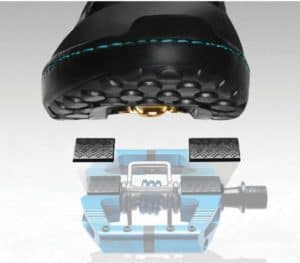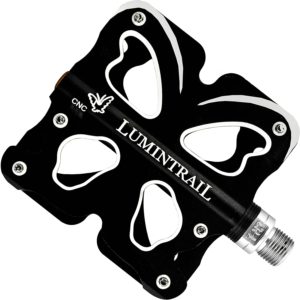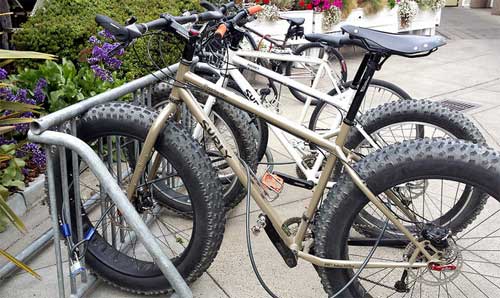If you ask hundreds of people which pedals they prefer, you’ll get 100 different answers. The only way to be sure is to try a few yourself.
You may try several systems before you find the one that works best for you. In this article, we try to explain what road bike pedals and touring pedals are.
Touring vs. Road bike pedals
Considering the best pedals for a vacation ride is primarily a matter of personal interest in road biking, where clipless pedals are the almost universal choice. We talk about clipless pedals later in the article. On the other hand, touring cyclists use a variety of pedals depending on what works best for them.
However, if you’re unsure which pedals to take on a bike ride and which pedals to use on the road, we’ll walk you through the pros and cons of the different types of touring pedals related to bike vacations.
Which bike touring pedal is best?
If you’ve taken up bike touring, you may be surprised to discover how many choices there are regarding pedals. Footpegs, no pedals or flat pedals. Which is the best pedal for touring? Let’s find out the pros and cons of each pedal.
Pedals With Cleats
 Pedals with cleats have more grip than regular flat pedals. You feel like you’re pedaling with cleats, which is especially nice on cloudy days when you don’t want your feet to escape over the pedals. When you want to get off your feet, it’s easy. You’re not attached to the pedals, so you can quickly remove your feet anytime.
Pedals with cleats have more grip than regular flat pedals. You feel like you’re pedaling with cleats, which is especially nice on cloudy days when you don’t want your feet to escape over the pedals. When you want to get off your feet, it’s easy. You’re not attached to the pedals, so you can quickly remove your feet anytime.
Advantages: affordable price. part of the grip while leaving your feet free to move
Disadvantages: It will get damaged if you bang your legs on the pedals while pushing the bike. Also, if you use your bike for touring and commuting, be aware that these pedals will scratch the shoes you might wear to work!
Clipless Pedals
Many bicycle tourists are interested in these. The name is a little confusing: “clipless” pedals. You clip your feet to the pedals, but the term ‘clipless’ indicates that these pedals do not have cages or toe clips.
There are many clipless pedals, one of the most common being Shimano’s SPD system. Other common brands build Eggbeaters and Frogs. They all work on the same principle: the cleats on your shoes attach to the pedals. When attached, pedaling is easier because you put energy into the upstroke and the downstroke. You drop your feet with a little outward twist when you’re ready to stop.
Advantages: It makes your bike up to 15% more efficient. It can help keep your feet more comfortable on the pedals in wet or bumpy conditions.
Disadvantages: The pedals, and the shoes that go with them, are more specialized than other types of pedals. If you need a replacement, they may be difficult or impossible to find in some countries. The learning curve for clipless pedals means you’ll probably fall off once or twice while you get used to clipping in. Pedals can cause knee pain if not fully adjusted.
platform pedals
 The positives of flat pedals are unwavering, they’re easy to use, and you don’t have to buy special bike shoes to use flat pedals. That alone means you’ll probably carry one less pair of shoes in your bucket, reducing weight and saving space. There are many platforms to choose from, including cheap plastic platforms, affordable heavy metal platforms, and more expensive light metal platforms.
The positives of flat pedals are unwavering, they’re easy to use, and you don’t have to buy special bike shoes to use flat pedals. That alone means you’ll probably carry one less pair of shoes in your bucket, reducing weight and saving space. There are many platforms to choose from, including cheap plastic platforms, affordable heavy metal platforms, and more expensive light metal platforms.
Advantage: Cyclists who like it simple. And cyclists who don’t want to “dress like cyclists.”
Disadvantage: Cyclists who are already avid SPD assigners and don’t like the feeling of foot movement or slippage while riding.
Compare both touring pedals.
Clipless pedals are generally not a good idea to use. They are designed for road bikes when you are touring. The pedals are designed to get as much out of the pedal stroke as possible.
The shoe is based on a very solid sole, without any flexibility. Therefore, even though the cleats are embedded, walking more than a small meter from the bike is not comfortable or easy.
On a cycling vacation, you’ll want to get off the bike much more frequently to look around a city or attractive building or to go into a store for lunch. Having to change shoes every hour or so makes these pedals unsuitable.
Perfection
First and foremost, I recommend flat pedals for your touring bike. You can choose the best flat pedals for touring bikes. There is an inconsiderable amount of snobbery desired by many cyclists towards other cyclists who use flat pedals. Regardless, for many bike tourers, flat pedals are the preferred option – and for a good reason. They allow you to wear the shoes you miss, come standard on most bikes, and are easy to use – without the risk of tipping over at traffic lights.
Road bike pedals: which road bike pedal is best
The best road bike pedal is the one that will make your ride more comfortable. There are many pedal models out there, with their own claimed merits. If you want a solid platform and adjustment, I recommend clipless pedals. They are widely used and well supported. They have an adjustable cleat with various functions and are probably the default choice for riders.
Looking for the pedaling efficiency of clipless pedals? Road bike pedals, from clipless to ultra-light clip-on pedals, are made to be light, strong, and smooth. With several types of road bike pedals to choose from, at price points that won’t shock your budget, everyone from the sudden weekend rider to the hardened cyclist will find the perfect road bike pedal for their needs.
Mechanically attaching your feet to a bike has many pros, but how do you choose the best road bike pedals that decide yours?
Clipless pedals:
The cleat that attaches to your shoe engages with the pedal. It’s spring-loaded and relieves itself with a simple twist of the foot. Rather than binding your feet rigidly, most clipless pedals allow some movement or “float”.
Picking the first thing the saleswoman chooses, the one that’s half the price of the exciting one, may not be the criteria chosen. We’ve rounded up clipless road bike pedals from the major manufacturers and tried them out for cyclists.
Advantage:
Clipless pedals keep your feet in place, making it easier to pedal at a good inflection. The speed at which you pedal is measured in revolutions of a pedal per minute. A good target is 70 to 90 revolutions per minute. They optimize the connection between the foot and the pedal so that more of your energy goes into each pedal stroke, which is ideal for climbs and long rides.
Most ultra systems offer some degree of float by assuming your feet line up with the pedals. This feature is like a stupid thing that helps prevent your knee problems. They help you when trying to fox the bike over resistance, like curbs, logs, and rocks. They won’t snag on the originals, sticks, and ruins like toe clips and straps when riding pedals or walking the trail with your bike.
They are easier to put on than toe clips and straps. With a bit of practice, they are safer to remove than finger clips and straps because the release motion is easier and more natural. They are better for pedaling when you buy shoes that fit your feet and pedals.
There is no cage to irritate your foot or cut your shoe and no strap to restrict circulation. They are lighter than fitted pedals and pedals with clips and straps. They’re pretty, stylish, and cool.
Disadvantage:
If you want to do more than a bike, you must get a second pair of shoes to explore on foot. The shoes are very bulk intensive and come with a weight penalty of 400-800 grams.
Perfection:
If you haven’t tried clipless pedals yet, I recommend clipless pedals for your bike. Here you will find the best clipless pedals for road bikes. At first, you may not like that you are on clipless pedals, but I can guarantee that unclipping will become second nature after a few weeks. Spending a few days or weeks with clipless pedals will help you determine if they are right for you or not.
